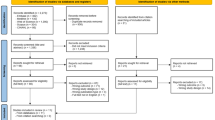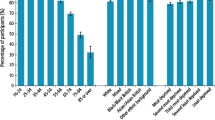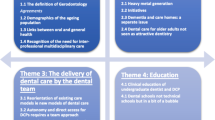Key Points
-
Regular care is defined as a visit for care within two years.
-
Oral health is defined within the psychosocial framework of 'discomfort, disability and discontent'.
-
Significantly more registered patients are regular than irregular attenders.
-
Significantly more regular attendees are healthier compared with irregular and new patients.
-
A 15 month registration time frame is inconsistent with developing equitable services.
Abstract
Objective The aim of this study was to examine the impact of attendance patterns on oral health in the context of government policy on dental care and registration in the UK.
Method The data involved 643 consecutive patient responses to a questionnaire on dental health taken from a survey that was conducted during 1998 in an urban area of Swansea. The survey continued for a period of six months and covered patients of 18 years of age and over, responding to a questionnaire on the subjective oral health status indicators including the pattern of their attendance to dental practices.
Results Regular dental care attendance has a significant positive impact on dental health while its impact on the number of teeth present is insignificant. Regular attendees also suffer significantly less from the severity, prevalence, social and psychological impacts of dental health problems.
Conclusion Regular dental attendance is associated with better oral health when regularity of care is defined as a visit within a two-year period. The rationality of a 15 month registration period is therefore debatable in the context of developing equitable services.
Similar content being viewed by others
Log in or create a free account to read this content
Gain free access to this article, as well as selected content from this journal and more on nature.com
or
References
The Health Departments of England, Scotland, Wales and Northern Ireland. The New Contract – An Operating Manual for Dentists London 1990.
Department of Health. Modernising Dentistry - Implementing the NHS plan 2001 London: Department of Health 2000.
Department of Health. GDSC.
The Health Education Authority. The Scientific Basis of Dental Health Education: A Policy Document 4th Edition 1996.
Tickle M, Williams MJ, Jenner AM, Blinkhorn AS The effects of dental attendance and socio-economic status on dental caries experience and treatment patterns in 5-year-old children. Br Dent J 1999; 186: 135–137.
Murray JJ Attendance patterns and oral health. Br Dent J 1996; 181: 339–342.
Kay EJ How often should we go to the dentist? Br Med J 1999; 319: 204–205.
Todd J, Lader D Adult dental health in the United Kingdom in 1988. London: HMSO 1991.
Reekie D Attendance patterns. Br Dent J 1997; 182: 169.
Sheiham A, Maizels J, Cushing A, Holmes J Dental attendance and dental status. Community Dent Oral Epidemiol 1985; 13: 304–309.
Richards W, Scourfield S Oral ill-health in a general dental practice in South Wales. Primary Dent Care 1996; 3: 6–13.
Bullock C, Boath E, Lewis M, Gardam K, Croft P A case-control study of differences between regular and casual adult attenders in general dental practice. Prim Dent Care 2001; 8: 35–40.
Department of Health. An oral health strategy for England London: Department of Health 1994.
McGrath C, Bedi R The value and use of 'Quality of Life' measures in the primary dental care setting. Prim Dent Care 1999; 6: 53–57.
Corson MA, Boyd T, Kind P, Allen PF, Steele JG Measuring oral health: does your treatment really make a difference. Br Dent J 1999 187 9: 481–484.
Locker D The burden of oral disorders in a population of older adults. Community Dent Health 1992; 9: 109–124.
National Statistics. Welsh Index of Multiple Deprivation Cardiff: The National Assembly for Wales 2000.
Locker D, Miller Y Evaluation of oral health status indicators. J Public Health Dent 1994; 54: 167–176.
Kelly M, Steele J, Nuttall N et al. Adult Dental Health Survey. Oral Health in the United Kingdom 1998. London: HMSO 2000.
Locker D, Miller Y Subjectively reported oral health status in an adult population. Community Dent Oral Epidemiol 1994; 22: 425–30.
Scully C The patterns of patient attendance for emergency care in a British dental teaching hospital. Comm Dent Health 1995; 12: 151–154.
Derry C, Fyffe HE, Nuttall NM, Nugent ZJ, Pitts NB The dental caries status of Scottish adolescents reported to be regular attenders. Br Dent J 1999; 187: 95–100.
Nuttall NM Review of attendance behaviour. Dent Update 1997; 24: 111–4.
Nyyssonen V Use of oral health services and adult oral health in Finland. Proc Fin Dent Soc 1992; 88: 33–38.
Eddie S, Davies JA The effect of social class on attendance frequency and dental treatment received in the General Dental Service in Scotland. Br Dent J 1985; 159: 370–372.
Richards W Oral ill health and deprivation amongst patients of a General Dental Practice in South Wales. Prim Dent Care 2002; 9: 105–112.
Sheiham A Is there a scientific basis for six-monthly dental examinations? Lancet 1977; 2: 442–444.
Elderton RJ Six-monthly examinations for dental caries. Br Dent J 1985; 158: 370–374.
Elderton RJ Routine six-monthly checks for dental disease. Br Dent J 1985 159: 277–278.
Kay EJ, Locker D Effectiveness of oral health promotion: a review. London: Health Education Authority 1997.
Moles DR Proceedings of BASCD Autumn Scientific Meeting. Comm Dent Health 1999; 16: 57–58.
National Assembly for Wales. Improving Health in Wales: A Plan for the NHS with its partners. Cardiff: NafW 2001.
Author information
Authors and Affiliations
Corresponding author
Additional information
Refereed paper
Rights and permissions
About this article
Cite this article
Richards, W., Ameen, J. The impact of attendance patterns on oral health in a general dental practice. Br Dent J 193, 697–702 (2002). https://doi.org/10.1038/sj.bdj.4801664
Received:
Accepted:
Published:
Issue date:
DOI: https://doi.org/10.1038/sj.bdj.4801664
This article is cited by
-
Brazilian adolescents’ oral health trends since 1986: an epidemiological observational study
BMC Research Notes (2015)
-
Preventive oral health practices of school pupils in Southern Nigeria
BMC Oral Health (2014)
-
Evidence summary: what is the effectiveness of alternative approaches for increasing dental attendance by poor families or families from deprived areas?
British Dental Journal (2010)
-
Dental service patterns among private and public adult patients in Australia
BMC Health Services Research (2008)
-
Factors influencing the use of public dental services: An application of the Theory of Planned Behaviour
BMC Health Services Research (2008)



